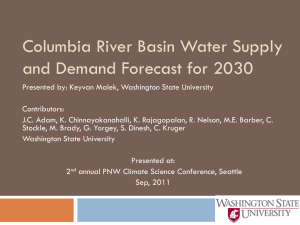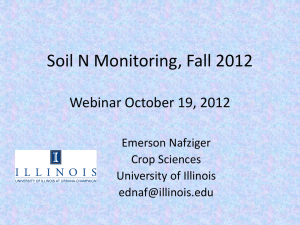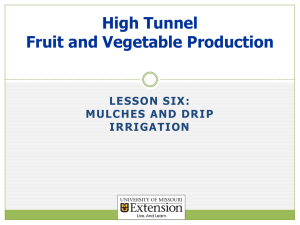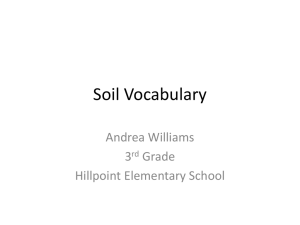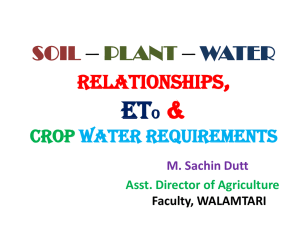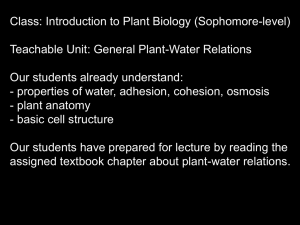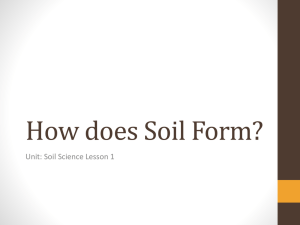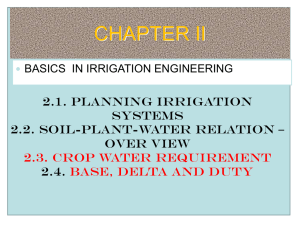Folie 1 - icarda
advertisement
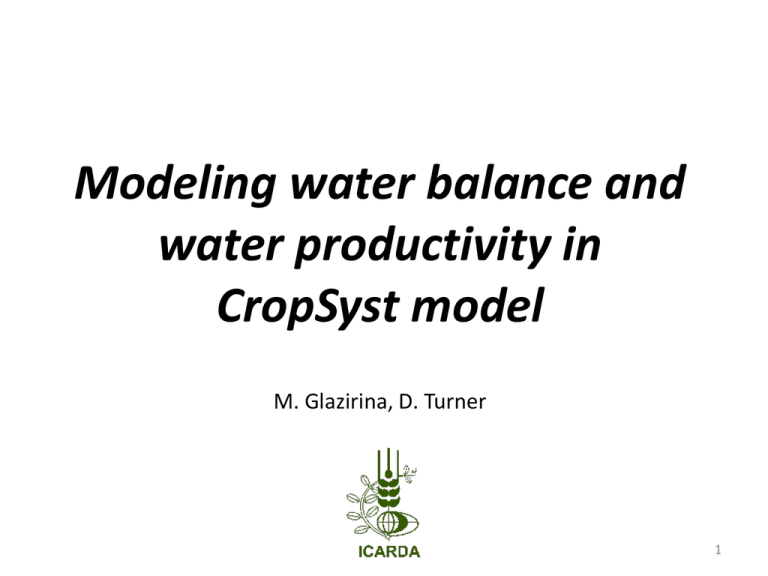
Modeling water balance and water productivity in CropSyst model M. Glazirina, D. Turner 1 CropSyst model description 2 CropSyst = “Cropping Systems Simulation Model” • programmed in C++ (object-oriented) by Prof. C. Stöckle and R. Nelson (Visual Basic for Application version available) • multi-year, multi-crop, daily time step simulation model • based on the understanding of plants, soil, weather and management interactions – – – – phenological development photosynthesis and growth stress effects (water, N, salt, (K)) root water uptake • Distributed free of charge via http://www.bsyse.wsu.edu/cropsyst/ 3 CropSyst - some detail • provides a – generic crop-growth component, allows adaptation/calibration to any crop; species and cultivars are characterized by a set of parameters which determine crop response to the environment – link to the GIS-software Arc/Info (spatial application) – report format editor for setting up output style, e.g. MS-Excel – fast graphics viewer • is very well documented, maintained and regularly updated! More specifically • considers the influence of soil salinity and shallow groundwater table, • allows using a finite difference solution of Richards equation to simulate water transport. • handles conservation agriculture features (to some extent) 4 Input-output fluxes in CropSyst Evapotranspiration Volatilization Rainfall Management: irrigation tillage Fertilization harvest Percolation Leaching CROP Runoff Soil loss SOIL Water rise Crop processes in CropSyst development growth light interception net photosynthesis biomass partitioning leaf expansion roots deepening leaf senescence water uptake nitrogen uptake water stress nitrogen stress light stress Soil processes in CropSyst water infiltration water redistribution runoff evaporation percolation solutes transport salinization nitrogen fixation residues fate O.M. mineralization nitrogen transformations water erosion ammonia volatilization ammonium sorption CropSyst data requirments Constant: Changing in time: Soil: • • • • Soil: Soil moisture NO3-N and NH4-N SOM Salinity • • • • • Weather: Precipitation Tmax, Tmin RHmax, RHmin Solar radiation Wind speed • • • • Management: Tillage Irrigation Fertilization Harvest • Texture • Hydraulic properties (bulk density, PWP, FC) • Chemistry (CEC, pH) Crop model Ground water and salinity Used for calibration: • • • • Crop: Phenology N-uptake AGB Yield • • • • Soil: Soil moisture NO3-N and NH4-N SOM Soil salinity 8 Water balance components in CropSyst model 9 Water balance equation P + I = ET + Inf + R + DS Where: The incoming water balance components: P - precipitation (including snow) I - irrigation The outgoing water balance components are: ET - Evapotranspiration Inf - Infiltration of water R - Surface runoff (natural) or surface drainage (artificial) DS is the change of water storage 10 Evapotranspiration model • Penman-Monteith comprehensive, precise – data requirements: precipitation, max. temp., min temp., solar radiation, wind speed, max relative humidity, min relative humidity • Priestley-Taylor simple, less precise – data requirements: precipitation, max. temp., min temp., solar radiation 11 Penman-Monteith Original: Δ(RN-G) RN = net radiation [W m-2] G = soil heat flux [W m-2] f(e) = VPD (vapor pressure deficit) [hPa] radiation term aerodynamic term Small modification in CropSyst: f(e) = DayFrac x VPDday_mean Fraction of day in daylight 12 Priestley-Taylor λET = PTc x Δ (RN-G) Δ+γ Priestley-Taylor "constant" • compensates for the elimination of the aerodynamic term (of the Penman or PM-model) • default 1.26, higher in arid regions AVOID USING Priestley-Taylor ET in arid regions! 13 Surface runoff 1 Surface runoff [proportion of rainfall] Two options: 1. SCS curve number (CN) approach (USDA-SCS, 1988) 2. numerical solution PAW=0.5 0.75 0.5 Daily rainfall = 70 m m 0.25 40 m m 10 m m 0 40 50 60 70 80 90 100 Curve number (CN) Erosion • RUSLE parameters: - Steepness (a percentage 0-100) - Slope length (m) 14 Soil water infiltration & redistribution • CropSyst provides basically two different models for choice: 1. cascade 2. finite difference 15 Cascade model • each given soil layer is defined by: – water content at saturation (SAT) – water content at drained upper limit (DUL, FC) – the permanent wilting point (PWP) • The difference between SAT and the current soil water content (Theta, Θ) determines the capacity of the layer to hold additional water • After infiltration events, a fraction of water in excess of DUL is drained based on a drainage rate constant • If Theta for the lowest soil layer exceeds DUL, the excess water is assumed to drain out of the profile • If the potential drainage for a layer is very large, the net drainage may be limited by the saturated hydraulic conductivity (Ks). 16 • • Finite difference model builds on the Richards equation – common flow equation for (un)saturated flow in porous media (as a soil can be considered) – is a parabolic non-linear partial differential equation of secondary order, which is solved numerically by a finite difference approach requires a parameterization (continuous form) of the soil hydraulic properties via: – – soil water retention characteristics pF-curve soil hydraulic conductivity SHC-curve CropSyst uses the so-called Campbell approach 17 Soil hydraulics according to Campbell ψsl = -a x WCl –b whereas a = e (ln(33) + b x ln(WC-33)) b= [ln(-1500/-33] [ln(WC-33/WC-1500)] • Soil hydraulic conductivity: 0.5 Loam, observed 0.45 Soil moisture [cm³ cm -³] • Soil water potential of layer l, ψsl: van Genuchten 0.4 Campbell 0.35 0.3 0.25 0.2 0.15 0.1 0.05 0 1 10 van Genuchten 100 whereas Campbell 10 K [cm/d] • air entry potential = (-a x Θs -b) 100000 1000 K = Ks x (Θ/ Θs) c c = 2b + 3 100 1000 10000 Soil water potential [hPa] 1 0.1 0.01 0.001 0.0001 1 10 100 h [hPa] 1000 18 10000 Output • • • • Daily report Seasonal report Annual report specific files: – cum_water_ depth.xls – hydraulic_ properties.xls – water_content.xls – water_depth.xls – water_potential.xls – … 19 Output • • • • • • • • • • • Water entering soil = Precipitation + Irrigation - Interception (crop&residue) Precipitation Irrigation Crop water Interception Residue water Interception Evapotranspiration = Soil evaporation + Transpiration + Residue evaporation Soil evaporation Transpiration Potential and actual Residue evaporation Infiltration Soil water depletion Water entering soil - Evapotranspiration – Infiltration = Soil water depletion 20 Crop growth in CropSyst 21 Crop Development • Crop development is the progression of a crop through phenological stages. • The proper simulation of crop development (phenological stages) is crucial – as it determines the length of time when the crop interacts with the environment – as it allows matching specific physiological conditions of a crop to specific environmental conditions. • Crop development is governed by growing degree days (GDDs) 22 GDDs Temperature Photoperiod GDDs Vernalization Water stress 23 Key phenological stages in CropSyst GDDs (°C days) from seeding to • Emergence • maximum rooting depth • Peak LAI (end of vegetative growth) • begin Flowering • begin Grain filling • Maturity Also expressed in GDDs: • Leave duration 24 Crop-growth – governing equations B Rad = Tlim RUE PAR (1 - e -k LAI ) Eq. 1 [kg m-2 day-1] 1- e(-k*LAI) 1 Adsorbed radiation [fraction] BRad = biomass production (radiation-dependent) Tlim = temperature-dependent limiting factor* RUE = radiation use efficiency [kg MJ-1] PAR = photosynthetic active radiation [MJ m-2 day-1] k = radiation extinction coefficient [-] LAI = leaf area index [m2 m-2] k = 0.5 0.75 k = 0.6 k = 0.7 0.5 k = 0.8 k = 0.9 0.25 k=1 0 0 1 * in view of optimum mean daily temperature for growth 2 3 LAI [m2 m-2] 4 5 6 25 Crop-growth – governing equations (cont.) B PT BTR Tact = VPD Eq. 2 BPT = biomass production (transpiration dependent) BTR = aboveground biomass transpiration coefficient [kg m-2 kPa m-1], often simply called Transpiration Use Efficiency Tact = actual transpiration [m d-1] VPD = vapor pressure deficit [kPa] Assumptions/Preconditions • Maintenance and growth respiration losses are accounted for in the experimental determination of BTR • The difference between leaf and atmospheric vapor density can be approximated by the atmospheric deficit expressed as the atmospheric vapor pressure deficit (VPD). 26 Transpiration dependent growth • CropSyst versions later than 4.12 offer three different modes for calculating BPT: 1. classical Tanner-Sinclair model • BTR is a constant, eq. 2 valid 2. FAO AquaCrop water productivity • BTR is a constant; VPD is not considered; equation 2 not used; unit of water productivity is g biomass/kg water) 3. Transpiration use efficiency curve 27 Crop growth • (optimal) crop growth is governed by the most limiting condition, either – radiation (eq. 1) or – transpiration (eq. 2). 28 Water limited growth, how? • via reducing transpiration… 29 Crop water uptake, WU (= Tact) soil layer n WU = Σ WUl [mm d-1] soil water potential l=1 leaf water potential WUl = K · Cl/1.5 · (ψsl - ψl) number of seconds per day = 86400 root conductance of soil layer l 30 A range of other "water" factors • • • • • • • • • • Act. to pot. transpiration ratio that limits leaf area growth Act. to pot. transpiration ratio that limits root growth Maximum daily water uptake ET crop coefficient at full canopy Leaf water potential at the onset of stomatal closure Wilting leaf water potential Leaf duration sensitivity to water stress Phenological sensitivity to water stress Initial leaf area index fraction of max. LAI at physiological maturity 31 Stress indexes Stress index is determined as one minus the ratio of actual to overall potential biomass growth for each day of the growing season. Potential growth is defined as the growth calculated from potential transpiration (Trpot) substituted for Tract. Actual biomass growth is obtained after growth limitations have been applied. This overall stress index is partitioned into light, temperature, water, and nitrogen stress indices. These quantities are used as indicators of the plant response to environmental conditions. All these indices range from 0 to 1, where 0 is no stress and 1 is maximum stress. 32 Climate change impact assessment using CropSyst (by example of wheat growing in Central Asia) 33 Objectives 1. Model calibration and evaluation for wheat grown under currently prevailing climatic conditions in selected agroeco-zones of the study region a. Crop model selection b. Site selection (by AEZ), and data collection (surveys) c. Crop model calibration 2. Definition of business-as-usual management 3. Generation of daily time-step weather data (historic and future) 4. Modeling the impact of climate change on crop productivity utilizing developed climate change scenarios 34 Potential biophysical impact of climate change on crop production in Central Asia 1. Increasing temperature – warmer winter and early spring (winter crops) better early crop growth, less damage by frost – hotter late-spring, hotter summer crop heat stress (lower grain production) – shorter cropping cycle lower biomass production 2. Changes in precipitation (amount and intensity) 3. Increasing CO2 – “carbon fertilization effect” moderate increase in crop growth • Interactions of 1. – 3. 35 Model selection criteria • Capacity to handle the impact of climate change on crop growth: – CO2 response – temperature response (cold & hot) – water stress (rainfall variability) • Capacity for reasonable prediction of – impact of shallow groundwater (GW-module; upward movement of water in the soil) – salinity response (saline soils) – evapotranspiration in arid environments – response to soil conservation measures (zero-tillage, surface residue retention) • Availability of further, useful modeling tools, such as – automatic irrigation 36 CO2 fertilization effect in CropSyst • increase in radiation use efficiency (ε) by a G-ratio factor • decrease in canopy conductance, increase of WUE Tubiello et al., 2000 37 Generation of weather data • Historic: data bases of national met-services, ICARDA and www • Future: using greenhouse gas emission scenarios of IPCC, 2007 – A2: pessimistic; assumes a continuous population growth, increasing divergence between regions, less transfer of technological innovations – A1b: neither optimistic nor pessimistic; assumes population stabilization, continued globalized world, balance between fossil-intensive and non-fossil energy sources • Future periods: – immediate future: 2011-2040 – mid-term future: 2041-2070 – long-term future: 2071-2100 38 38 Climate change – CO2 concentrations Increase of the atmospheric CO2 concentration as predicted by SRES A1B and A2 (redrawn from IPCC, 2000) 39 Projections of climate change • Underlying data base: seven IPCC GCMs No Name Country Year Resolution (degrees) 01 BCCR-BCM2.0 Norway 2005 2.8 x 2.8 02 CSIRO-MK3.0 Australia 2001 1.9 x 1.9 04 MIROC3.2 Japan 2004 2.8 x 2.8 08 CGCM3.1(T63) Canada 2005 2.8 x 2.8 09 CNRM-CM3 France 2005 2.8 x 2.8 10 ECHAM5/MPI-OM Germany 2003 1.9 x 1.9 12 GFDL-CM2.0 USA 2005 2 x 2.5 average deviation (delta) from historic climate (temperature and precipitation) of the seven models 40 40 Business-as-usual (BAU) • Definition of agronomic management scenarios based on the usual farmer’s practice Model simulations should reflect reality 41 41 Business-as-usual (BAU) Information about BAU: From socio-economists team: 1. Fertilizer type 2. Fertilizer amount 3. Week of planting 4. First week of irrigation 5. Last week of irrigation 6. Number of irrigation events 7. Week of harvest BAU Planting date optimal average Depending on location sub-optimal + National recommendations: 1. Dates of fertilizer application 2. Dates of irrigation 3. Irrigation rates Fertilizer application highest average/median Irrigation lowest water stressed recommended average 42 Weather generators LARS-WG stochastic weather generator Developed by M. Semenov (Rothamsted Research of BBSRC) ClimGen Available at: Available at: modified version of WGEN developed by Gaylon S. Campbell, Washington State University http://www.bsyse.wsu.edu/CS_Suite/ClimGe http://www.rothamsted.bbsrc.ac.uk/mas43 n/index.html models/larswg.php 43 Climate change simulations Historic daily meteorological data: precipitation, solar radiation, Tmax, Tmin, RHmax, RHmin, wind speed Soil: •Soil physical properties •Nmin and SOM •Soil salinity •Groundwater Crop: •Crop physiology •Crop phenology Management : •Planting date • Irrigation, fertilization •Tillage Weather generator Generated daily meteo data CropSyst Simulations Location Regional downscaling Scenario 4 Scenario 3 Current conditions Scenario outputs GCM - СС Scenario 2 Scenario 1 44 44 Climate change crop model simulation results – major governing factors • higher temperatures: → → → → faster growth, shorter growing season less time for biomass accumulation higher evaporative demand increase in crop water requirements “warmer” (less cold) winters and springs less frost damage, faster early growth in spring hotter late spring and summer increased risk of sterility of flowers • higher precipitation: → → more water for the crop increased risk of nitrate leaching • higher concentration of CO2: → carbon fertilization effect 45 Selected sites Country Kazakhstan Uzbekistan Site name Shieli Vozdvizhenka Petropavlovsk Kostanay Khorezm Syrdarya Kushmanata Kuva Akkavak (2 experiments) AEZ 310 521 821 521 310 510 510 310 510 Country Tajikistan Kyrgyzstan Site name Faizabad Shahristan Khorasan Bakht Spitamen Uchkhoz Zhany pakhta Daniyar KyrNIIZ AEZ 1032 532 510 510 510 510 510 510 510 46 46 Climate change projections for the selected sites 47 CC simulation results: Grain yield Akkavak – Mars, (UZ, irrigated) Yield (Mg/ha) 6 4 * * * * I M L I M L A1b A2 LSD (0.42 Mg/ha) 2 0 H I M L A1b I M L H A2 Suboptimal Mgmt. I M L A1b I M L H A2 Average Mgmt. Optimal Mgmt. 48 Days from emergence until maturity Days from emergence till maturity Example: Kushmanata (UZ) 240 -10 days -12 days 230 Avg. ( ±SD) Min 220 Max 210 H I M A1b L I M A2 L 49 (Minimum) temperatures during vegetative growth Change in average temperature across all sites and scenarios Immediate Mid-term future future Avg. Range + 0.8 0.6-1.0 + 1.7 1.4-2.4 Long-term future + 2.9 2.2-4.1 50 Maximum temperatures during flowering Astana 40 50-year Max. T (°C) 35 95%-Perc. 30 Avg. (±SD) 25 20 I Hist. M A1b L I M L A2 51 Irrigation Irrigation (mm) (mm) (mm) Irrigation Irrigation (mm) Kuva Irrigation water requirements 400 Subopt. Mgmt. A1b Subopt. Mgmt. A2 Shieli 300 Avg. Mgmt. A1b Avg. Mgmt. A2 250 200 Optimal Mgmt. A1b Kuva 200 Optimal Mgmt. A2 100 400 Subopt. Mgmt. A1b 150 0 300 100 Subopt. Mgmt. A2 H I M Kuva Avg. Mgmt. A1b L Avg. Mgmt. A2 200 50 400 OptimalMgmt. Mgmt. A1b A1b Subopt. 0 100 OptimalMgmt. Mgmt. A2 A2 Subopt. 300 0 200 Overall: H I M L Avg. Mgmt. A1b Avg. Mgmt. A2 • no noteworthy change Optimal Mgmt. A1b H I M L Optimal Mgmt. A2 • Some sites: reduction in irrigation water requirement 52 100 Water use efficiency Grain yield vs. actual transpiration, all Uzbek sites Historic 10 7.5 5 7.5 5 2.5 2.5 0 0 0 100 200 300 400 500 Actual transpiration (mm) 600 Slope (kg/ha/mm): 25.8 22.5 20.3 18.3 Long-term Mid-term Immediate Historic y = 18.3x – 405.6 R² = 0.758 Yield (Mg/ha) Yield (Mg/ha) 10 0 100 200 300 400 500 Actual transpiration (mm) Transpiration Use efficiency increased from 18.3 kg/ha/mm under historic (CO2) conditions to 25.8 kg/ha/mm in the long-term future 53 Thank you for your attention! 12th CGIAR Steering Committee Meeting for Central Asia and the Caucasus, September 12-14, 2009, Tbilisi, Georgia 54

